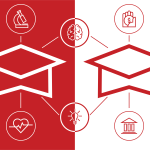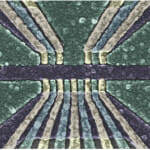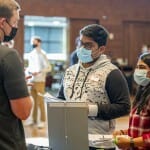Tag Computer science
UW–Madison researchers win prestigious Sloan fellowships
UW–Madison’s 2025 Sloan Fellows are James Roberts Crall, assistant professor of entomology, and Sharon Yixuan Li, assistant professor of computer sciences. Read More
UW’s hottest double majors: Pairings broaden knowledge and widen opportunities
Roughly 30 percent of UW grads major in two or more areas, a rate that’s been stable for at least a decade. Pursuing multiple majors is particularly popular in fields like computer science, business and economics. Read More
New major in information science draws wide array of students with human-centered approach
Graduates will be prepared with computing, analytical and people skills for a large variety of jobs in companies and organizations that need tech and data-savvy employees. Read More
UW students get taste of real-world learning
Through capstone courses, internships and partnerships with employers, students have worked on projects all over the state and nation. Read More
UW’s 5 hottest majors: Student demand, workforce trends drive enrollment gains
UW–Madison is constantly evolving to make sure higher education captures student interest and meets the needs of employers here in Wisconsin and around the world. Read More
Finding some wiggle room in semiconductor quantum computers
A new housing for quantum semiconductors upends conventional wisdom, achieving more perfect computations thanks to its less-than-perfect design. Read More
Saying ‘grazie’ to a mentor
"While everyone can use a good mentor, I think some people cannot make it very far without one. I was one of those people." Read More
UW School of Computer, Data & Information Sciences adds three degree programs
The new degree programs, which will launch in the fall, are designed to increase skills that are in high demand, preparing a talent pipeline that will drive economic growth in the region and beyond. Read More
CDIS job fair proves popular
Students flocked to School of Computer, Data & Information Sciences job fair on Feb. 15 at Union South, to meet with representatives from a variety of companies offering opportunities. Read More
App repairs student connections torn by pandemic
Demic is an app created by students that facilitates academic support and social connection among UW–Madison students. About 800 students have already joined the app, which launched at the beginning of the semester. Read More
Research aims to give everyone a fair shot at accessing COVID-19 vaccines
A UW team's work will inform government and community groups’ efforts to address vaccine access and hesitancy, with the ultimate goal of increasing immunization rates. Read More
Human-Computer Interaction focuses on technology to improve daily lives
Human-Computer Interaction research at UW–Madison aims to make technology more accessible while fostering efficiency in human-centered tasks. Read More
New Data Science degree emerges as the fastest growing major at UW–Madison
The decision to create the Data Science major came after a university-wide recognition that this field of study is one of the most rapidly emerging career sectors in the nation. Read More
UW startup DataChat democratizes data science
The company's growth since being founded in 2017 illustrates the many ways UW–Madison nurtures start-ups that arise from its research. Read More
UW focuses on engaging women in computer sciences
Funding from the grant will allow the computer sciences department to expand pathways for students including strategies to encourage students to enroll in entry level classes, augmenting curricula to create smoother transitions from entry level to more advanced coursework, and providing staff support and funding to develop community and cohorts. Read More
Cellular networks vulnerable to wildfires across U.S.
More than 430,000 cell network transceivers covering approximately 85 million people are in areas the U.S. Forest Service considers at moderate or high wildfire risk. Read More
Seeding tech growth in Wisconsin’s fertile ground
A Global Startup program will nurture high-tech entrepreneurs in the risk management industry, in a partnership with UW–Madison and American Family Insurance Read More
American Family Insurance Data Science Institute awards “mini grants” to advance data science
The emerging field of data science is the study, development or application of methods that reveal new insights from data. The successful projects will further research ranging from third-wave artificial intelligence to student entrepreneurship. Read More




















